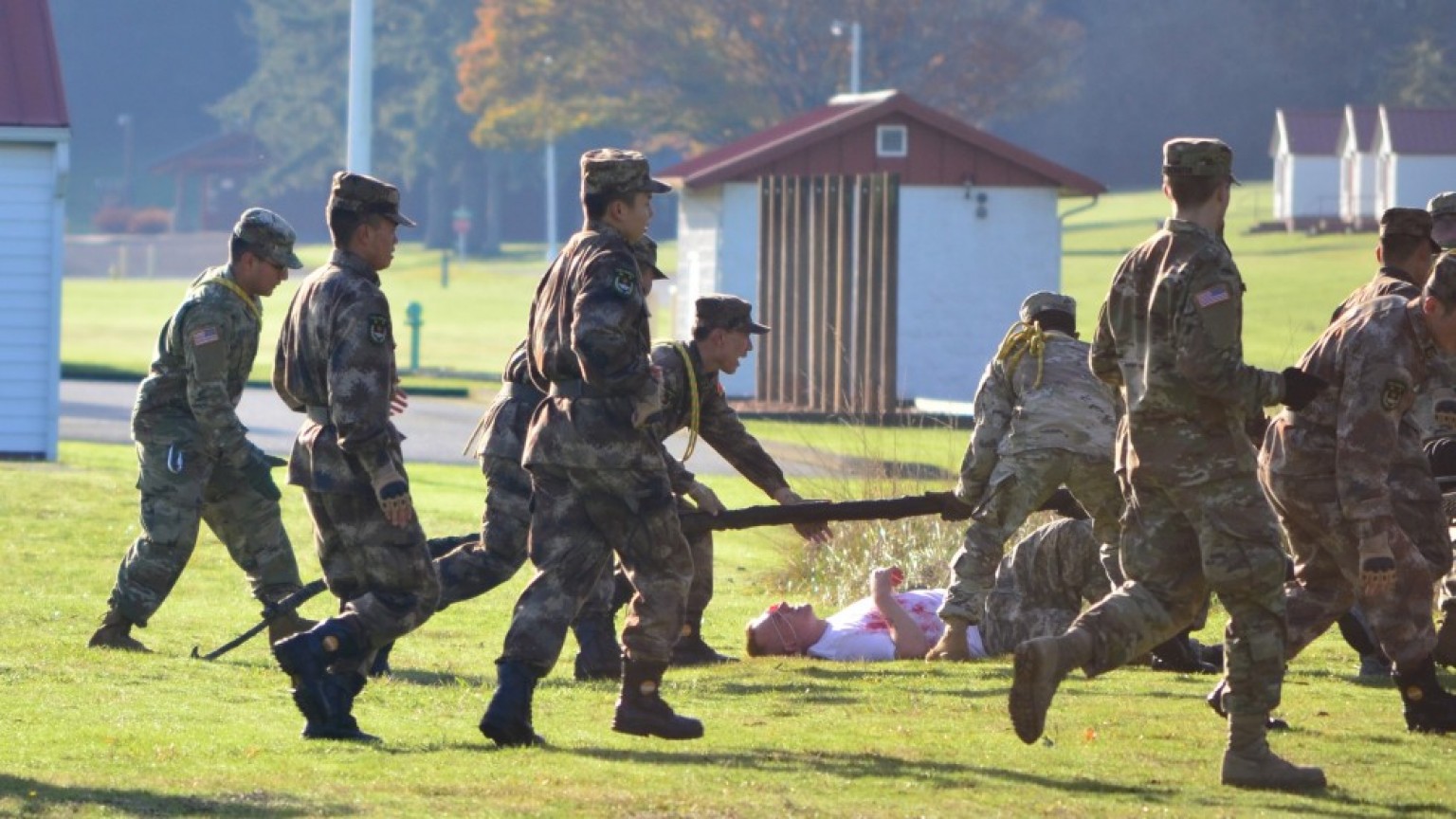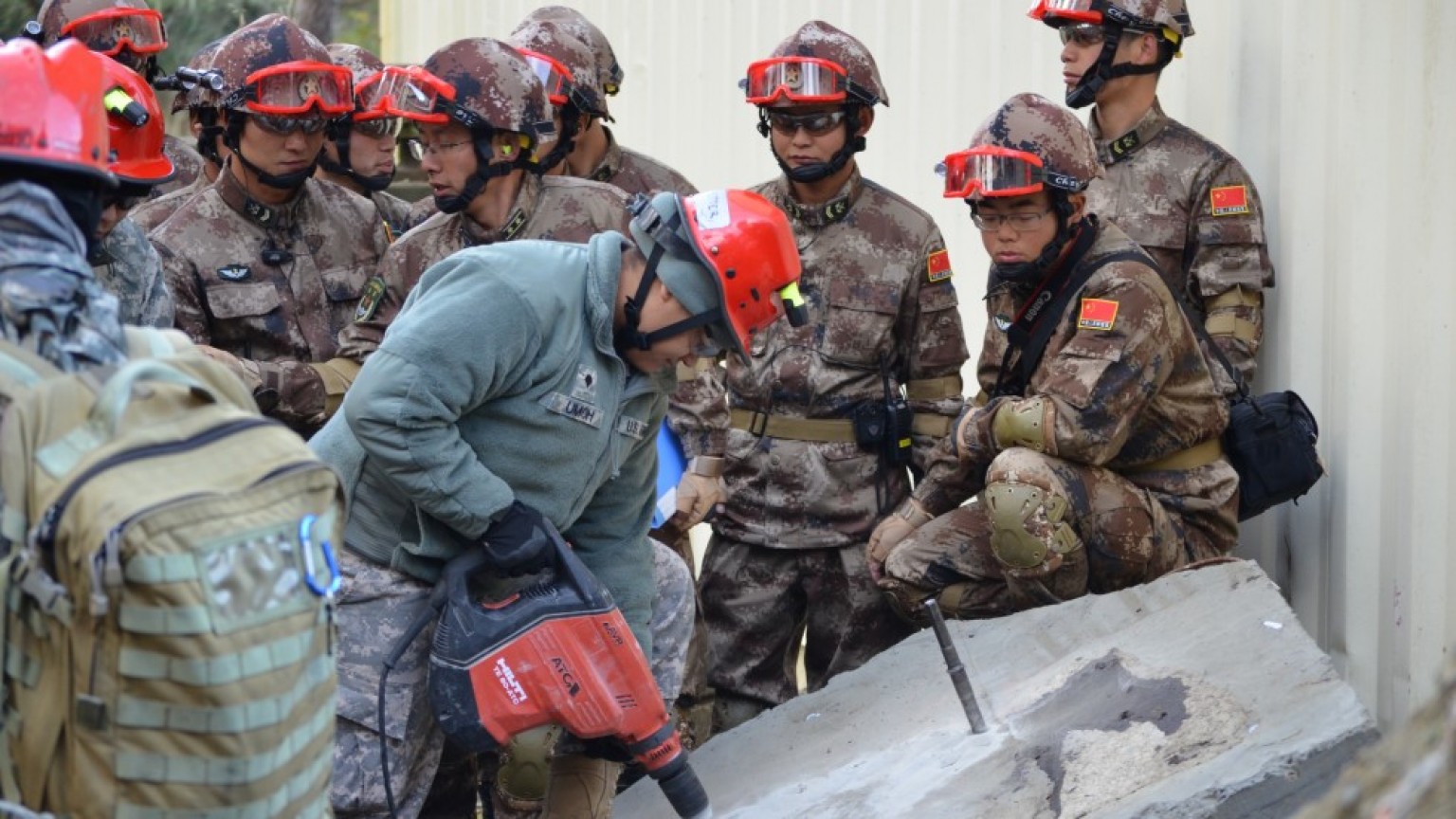
What It'll Take to Achieve U.S.-China Military Cooperation
It’s mid-November and Chinese troops are training at Camp Rilea on Oregon’s northern coast. They had arrived on American soil just as President Donald Trump was wrapping up his first official state visit to Asia. The president’s unpredictable behavior, especially when relating to foreigners, isn’t lost on some of the U.S. soldiers on site; one quietly confides he had worried whether Trump’s overseas visit would impact this preplanned meeting between soldiers of two of the world’s leading powers, formally known as the annual Disaster Management Exchange.
A crises-relief training event that couples American and Chinese military personnel, the Disaster Management Exchange is notable in that it invites Chinese troops to a U.S. military training facility. China and America take turns hosting each year; next year, the Americans will go to China. More than a dozen Chinese reporters are on the scene; to them, this is a big international story. But there are only four American journalists, and two of them from the local small town paper. Despite the best efforts of U.S. Army officials, they weren’t able to entice many outlets to notice this event, which has drawn dozens of high-level officials flocking to the rural coast of the Pacific Northwest.
Foreign military observers from Canada, Japan, Bangladesh, the Philippines and Singapore are here to watch, however, and to take notes. After all, each nation has its own stake in how these two militaries interact with each other, and it’s been a particularly tense year in Asia. In 2017 alone, Chinese and Indian troops have engaged in a border dispute that may or may not have involved a brawl with clubs and rocks. Kim Jong Un’s brother was assassinated in Malaysia, likely on the supreme leader's orders. The United States entered a new chapter in its tense, enduring standoff with North Korea over nuclear weapons testing, leaving both nations seemingly a tweet away from war. The regime in Myanmar stands accused of genocide as Rohingya refugees flee by the millions to Bangladesh and Japan announced it’ll be ready to beef up its own military resources to defend itself in what it sees as an increasingly volatile region. Three weeks after this year's Exchange concluded, President Trump shocked the world by announcing that the U.S. would begin to recognize Jerusalem as the capital of Israel—a policy position that completely opposes Chinese President Xi Jinping's 2016 announcement that China supports a Palestinian state with its capital in eastern Jerusalem.
The Pentagon continues to view China broadly; a rival at best and at worst, an adversary.
Throughout his presidential campaign, Trump criticized Asian nations and particularly China, accusing it of stealing American jobs and wealth. At the time, North Korean state media praised Trump as “forward thinking” for suggesting he would pull out U.S. troops from South Korea and Japan, a complete reversal of Barack Obama’s “pacific pivot” strategy to strengthen the U.S. military’s presence on the continent. True to his form, no one on either side of the Pacific Ocean knows what to expect from President Trump next.
At Camp Rilea, with the president on his best behavior overseas, Chinese and American troops have chosen to continue their training as usual, building on the Exchanges of previous administrations, when America’s Commander in Chief was less incendiary. “It’s been a good time,” says First Lieutenant Caleb Tumulty, a member of the Oregon National Guard’s search and rescue team, as he reflects on eating with his Chinese counterparts and watching American and Chinese troops bum cigarettes off of each other. “You can have areas of differences and still find many things in common where you can work together,” General Robert Brown, commanding general of U.S. Army Pacific, tells Playboy. “Lives will depend on working together…and you can’t form those relationships during the crisis.”
“I found the people here are warm and friendly. They’re very considerate,” Lieutenant Ma Sihua, a young Chinese officer, tells me. “The cook in the dining hall cooked Chinese food—what he thought was Chinese food at least.” This is Ma’s first time overseas, but other Chinese troops recount how they'd been deployed to Lebanon, Laos and elsewhere as peacekeepers.

U.S.-China relations have always been something of a rollercoaster. The two militaries fought some of their bloodiest battles against each other during the Korean War, leading to deep hostilities until President Richard Nixon’s 1972 visit thawed relations. A 2001 collision between a Chinese fighter jet and a U.S. Navy spy plane caused America’s first diplomatic crisis of the new millennium. The 9/11 attacks, however, and the resulting War on Terror quickly shifted American priorities.
Relations between Beijing and Washington have improved significantly in the last 15 years. But the Pentagon continues to view China cautiously; a rival at best and at worst, an adversary. General Joseph Dunford, the current Chairman of the Joint Chiefs of Staff nominated to his post by President Obama, has repeatedly testified to Congress that he considers China and Russia to be bigger threats to American interests than ISIS or al-Qaeda.
In the past, both nations have looked for ways to expand their military partnership but at times, such efforts have only helped illustrate the complexity of the relationship. In 2014, the United States invited China’s Navy for the first time to attend to the biannual Rim of the Pacific, better known as RIMPAC. It’s the largest maritime exercise on the planet with participation from 26 countries, situated near Hawaii. China accepted the invite and sent its hospital ship Peace Ark, but it also sent an uninvited guest: a Dongdiao-class spy ship that observed the exercise from afar.
Tensions have mounted between the two militaries in the Pacific as the Chinese military moves to assert more control.
But Admiral Samuel J. Locklear III, then Commander of the U.S. Pacific Command, seemed unconcerned. In a way, he felt it actually vindicated American surveillance activities around Chinese territory. “The good news about this is that it’s a recognition, I think, or an acceptance by the Chinese of what we’ve been saying to them for some time,” he told The Diplomat at the time. “That military operations and survey operations in another country’s exclusive economic zone, where you have your own national security interest are within international law and are acceptable. And this is a fundamental right that nations have.”
Tensions have mounted between the two militaries in the Pacific as the Chinese military moves to assert more control, having gone so far as building manmade islands for airstrips and troops. In July, China’s officially opened its first overseas military post in the East African nation of Djibouti, also home to the U.S. military’s own Camp Lemonier. China has spent the last few years heavily investing in Africa, which some experts say is a move to directly compete with the United States.
As a result of this hot-and-cold relationship, military-to-military relations remain largely focused on humanitarian relief operations. Thus the annual Disaster Management Exchange. It’s an inoffensive way to work together and meet face-to-face. “Anyone should be able to work together to save lives,” says Staff Sergeant Jonathon Jason, a 20-year Army veteran at Camp Rilea. “It doesn’t matter if we’re officially…” He pauses. “Well, anything.”
The Asia-Pacific region in particular is prone to natural disasters in the form of earthquakes, tsunamis, typhoons and floods. In 2008, the U.S. military flew $1.5 million of aid to China after a 7.9-magnitude earthquake in Sichuan province killed more than 39,000 people. In 2013, the Chinese Navy sent its 300-bed Peace Ark to the Philippines as part of the response to the devastating Typhoon Haiyan following the United States’s commitment of 9,500 military personnel. During the 2015 Nepal earthquakes, both the American and Chinese militaries sent troops to help with relief efforts.

These experiences have influenced trainings and what U.S. and Chinese leaders discuss. Senior officers from both countries gather in a multinational command center along with civilian aid officials to talk strategic planning, often running through numbers and scenarios inspired by real-life disasters. “Multinational response has proven to be the most effective method to save lives,” Brown tells the mixed crowd of troops at Camp Rilea. “It was central during the earthquakes in Nepal, the 2008 Sichuan earthquake and other devastating events across the Indo-Pacific region. Ultimately, this is about minimizing suffering in disaster zones.”
But a major pillar of the Trump administration is rejection of globalism and multilateralism. Trump made a big show of withdrawing the United States from the Paris Agreement, trashing NAFTA and, while he spoke glowingly of President Jinpeng during his Asia visit, he could easily flip the script as soon as his Twitter feed has something to gain from his MAGA brand of isolationism. “Trump is slowly but surely filling out his Asia team at the National Security Council, State Department and Defense Department,” wrote China policy expert Ely Ratner in The Interpreter after Trump’s return from Asia. “There’s a near consensus among these political appointees—shared throughout the administration—on the need for a more competitive strategy toward China. That will begin to show.”
Both countries seem increasingly agitated by North Korea’s unpredictable moves. Though China and North Korea are allies by treaty and fought Americans side-by-side during the Korean War, their relationship has become more complicated. In 2014, Wang Hongguang, a retired general, wrote an op-ed in a state-run newspaper criticizing North Korea’s nuclear program and asserting that “China has cleaned up the DPRK’s mess too many times.” In October, Chinese authorities detained suspected assassins they believed were on a mission to assassinate Kim Jong Un’s dissident nephew, Kim Han-sol.
Just one day after North Korea’s surprise missile launch on November 28, top U.S. and Chinese military officials met quietly at the National Defense University in Washington. U.S. officials insisted that the closed-door talks were scheduled long before North Korea’s missile test and that conversations didn’t center on North Korea specifically.
While the two militaries can talk and occasionally work together, no one is under the illusion that they have an alliance. Even so, Brown feels optimistic as he watches 2017’s Disaster Management Exchange wind down. "The tensions that happen don’t really impact this, because we’ve found an area of common interest, and that’s saving lives,” he says. “In my 37 years in the military, I’ve found that when you find things in common, it enables you to more easily talk about your differences. If you don’t find things in common, you just focus on differences and that’s not effective for anyone."







